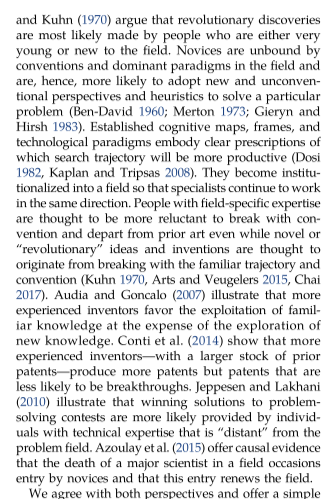joelchan's working notes
Powered by 🌱Roam Garden@artsParadiseNoveltyLoss2018a for [[QUE - How might domain distance modulate the effects of analogies on creative output?]] | if inventor files a patent in a new field they haven't explored before, their patent tends to be more novel; there's also a citation penalty, but this gets canceled out if they collaborate with an expert in the new field
correlation + natural experiment from unintended change in noncompete labor law
exploring new fields ++ novelty but --value (proxied with raw citations)
per @wangBiasNoveltyScience2017 be super careful about this outcome measure of value given [long vs. short run differences for highly novel stuff]([[EVD - highly novel papers were more likely to be in the top 1% of citations in the long run, but not in the short run, and particularly in other fields - @wangBiasNoveltyScience2017]])
the relevance for our question here is that inventors who explore a new field (to the extent that it is different from their own) and then later go on to invent new things that are better are at least possibly (we don't know for sure) doing a form of far analogies or conceptual combination: tough to distinguish.
i really want to watch out for whether they make any attempt to trace actual relationships between the things cited and the things proposed, *conceptually* (in content terms)
what did they do?
study 1: correlational study
sample: ~400k inventors of ~2.7M patents, across ~47k firms

estimation strategy: inventor-firm fixed effects panel models
dependent measure: novelty = number of pairwise subclass combinations in the focal patent that appear for the first time in the patent database
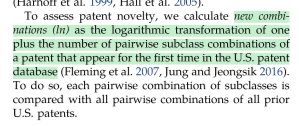 (p. 5)
(p. 5)
similar to @wangBiasNoveltyScience2017
dependent measure: "value" = number of forward citations in the 10 years after the patent is approved
 (p. 5)
(p. 5)
independent variable: exploring new fields = 0 or 1 (if focal patent has no overlapping classes with all prior patents from the same inventor)
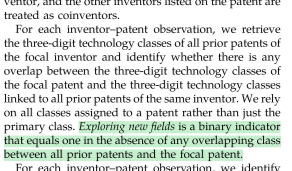
independent variable: expert team = 1 if at least one co-inventor has prior patent with same class as focal patent (else 0)
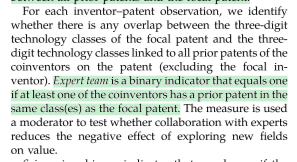
study 2: natural experiment with michigan antitrust reform act
context: Michigan Antitrust Reform Act (MARA)
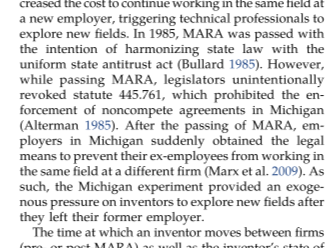 (p. 11)
(p. 11)
sample: ~29k inventors of ~162k patents in michigan vs. not-michigan who filed patents after moving firms within the same state between 1975 and 1995 (+/- 10 yrs of MARA law passing)
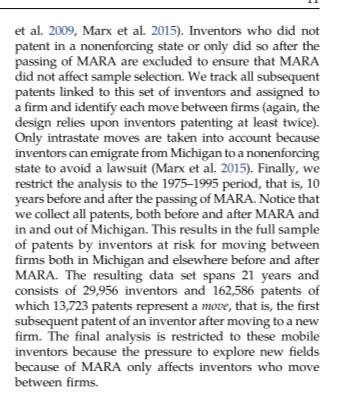 (p. 11)
(p. 11)
estimation strategy: difference in difference analysis
what did they find?
[[EVD - patents filed by inventors who was new to the patent's field tended to be more novel; this was less true if they collaborated with an expert in the new field - @artsParadiseNoveltyLoss2018a]]
[[EVD - patents filed by inventors who was new to the patent's field tended to receive slightly fewer citations, except when they collaborated with an expert in the new field - @artsParadiseNoveltyLoss2018a]]
there's also a result here that is similar to what @kneelandExploringUnchartedTerritory2020 finds re: science citations: positive effect of citing nonpatent prior art (mostly science pubs)
what might this mean?
the results about expert collaborations in new fields reversing negative effects on forward citations (without canceling out novelty advantage) is really interesting and relevant for [[QUE - What are the most efficient routes to useful cross-boundary knowledge?]]
side notes
➰ breadcrumbs more citations for the outsider innovation effect, leaning a bit more on the "useful naivete" mechanism rather than "transferring in new things" piece
